FOUNDATION FOR INTELLIGENT PHYSICAL AGENTS
FIPA Agent Management
Support for Mobility Specification
|
Document title
|
FIPA Agent Management Support for Mobility Specification
|
|
Document number
|
PC000087A
|
Document source
|
FIPA Architecture Board
|
|
Document status
|
Preliminary
|
Date of this status
|
2000/06/30
|
|
Supersedes
|
None
|
|
Contact
|
fab@fipa.org
|
|
Change history
|
|
2000/06/05
|
Carried forward from FIPA 1998 Specification 11 V1.0
|
|
2000/06/30
|
Editorial changes; made :code-base
parameter optional
|
© 2000 Foundation for Intelligent Physical Agents - http://www.fipa.org/
Geneva, Switzerland
|
Notice
|
|
Use of the technologies described in this specification may infringe
patents, copyrights or other intellectual property rights of FIPA Members and
non-members. Nothing in this specification should be construed as granting
permission to use any of the technologies described. Anyone planning to make
use of technology covered by the intellectual property rights of others
should first obtain permission from the holder(s) of the rights. FIPA
strongly encourages anyone implementing
any part of this specification to determine first whether part(s)
sought to be implemented are covered by the intellectual property of others,
and, if so, to obtain appropriate licenses or other permission from the
holder(s) of such intellectual property prior to implementation. This
specification is subject to change without notice. Neither FIPA nor any of
its Members accept any responsibility whatsoever for damages or liability,
direct or consequential, which may result from the use of this specification.
|
Foreword
The Foundation for Intelligent Physical Agents
(FIPA) is an international organization that is dedicated to promoting the
industry of intelligent agents by openly developing specifications supporting
interoperability among agents and agent-based applications. This occurs through
open collaboration among its member organizations, which are companies and
universities that are active in the field of agents. FIPA makes the results of
its activities available to all interested parties and intends to contribute
its results to the appropriate formal standards bodies.
The members of FIPA are individually and
collectively committed to open competition in the development of agent-based
applications, services and equipment. Membership in FIPA is open to any
corporation and individual firm, partnership, governmental body or
international organization without restriction. In particular, members are not
bound to implement or use specific agent-based standards, recommendations and
FIPA specifications by virtue of their participation in FIPA.
The FIPA specifications are developed through
direct involvement of the FIPA membership. The status of a specification can be
either Preliminary, Experimental, Standard, Deprecated or Obsolete. More detail about the process of
specification may be found in the FIPA Procedures for Technical Work. A
complete overview of the FIPA specifications and their current status may be
found in the FIPA List of Specifications. A list of terms and abbreviations
used in the FIPA specifications may be found in the FIPA Glossary.
FIPA is a non-profit association registered in
Geneva, Switzerland. As of January 2000, the 56 members of FIPA represented 17 countries worldwide. Further
information about FIPA as an organization, membership information, FIPA
specifications and upcoming meetings may be found at http://www.fipa.org/.
Contents
1 Scope. 2
2 Agent Management Support for Mobility Reference Model 3
2.1 Protocols as a
Metaphor for Expressing Mobility. 3
2.2 Mobility Life
Cycle. 4
2.3 Mobility Protocols. 5
2.3.1 Agent Migration. 6
2.3.2 Agent Cloning. 2
2.3.3 Agent Invocation. 2
2.4 Agent Profiles. 2
3 Agent Mobility Ontology. 2
3.1 Object
Descriptions. 2
3.1.1 Mobile Agent
Description. 3
3.1.2 Mobile Agent Profile. 3
3.1.3 Mobile Agent
System.. 3
3.1.4 Mobile Agent Language. 4
3.1.5 Mobile Agent
Operating System.. 4
3.2 Function
Descriptions. 4
3.2.1 Migrate a Mobile
Agent 5
3.2.2 Transfer the
Identity of a Mobile Agent 5
3.3 Exceptions. 5
3.3.1 Failure Exception
Propositions. 5
4 Annex A - Integration of FIPA Agent Mobility and MAF. 6
5 References. 8
FIPA is concerned with two types of
mobility; mobility in devices such as portable computers and Personal Digital
Assistants (PDAs) that can be intermittently connected to the network, and
mobility in software such as mobile agents that can move between hosts.
This specification is concerned with
specifying the minimum requirements and technologies to allow agents to take
advantage of mobility. This specification integrates closely with [FIPA00023]
and provides a wrapping mechanism for existing mobile agent systems to promote
interoperability. Therefore, the scope of this specification is limited to:
·
This specification does not mandate
the use of mobility features. Instead, it mandates how agents and APs may
support mobility, if mobility is desired.
·
This specification does not mandate
the use of any explicit technology for supporting mobility. Instead, it
provides a wrapping mechanism for mobile agent systems.
·
This specification does not define how
mobile agents and mobile agent systems operate or are implemented. However, the
mobility capabilities defined in this specification rely on their existence.
·
Mobile agent security is not currently
addressed by this specification. This topic will be addressed in future
versions of this specification.
·
This specification defines extensions
that are necessary to the AMS to support mobility.
·
The platform profile can become a
standard way for an agent to discover the type of mobility supported by an AP.
If an AP does not support mobility, then it should refuse any mobility
operation.
It is recognised that there are many ways
of expressing mobility within agents, such as code mobility, agent migration
and agent cloning. For this reason, FIPA does not mandate a single form of
agent mobility but supports a core set of actions that allow flexible and
extensible forms of mobility protocols to be supported. Two example protocol
abstractions are explained here:
·
Simple Mobility Protocols
An agent relies
on a high level protocol that uses a single action (for example, move) which causes it to be moved to a
destination AP. In this case, the AP upon which the agent is executing will
have to implement the necessary protocol to realise the entire migration
operation. This is illustrated in Figure
1, where an agent is delegating its mobility operation to the agent
platform.
The perceived
advantages of the simple mobility protocols are that there is a reduced
complexity in application agent development since mobility is supported by the
AP, they are oriented towards existing mobile agent frameworks (for example,
[OMGmaf]) and easy implementation on existing mobile agent platforms via FIPA
ACL enhancement, and, there is a reduced number of remote interactions.

Figure 1: Example Simple
Mobility Protocol
·
Full Mobility Protocols
An agent directs
the mobility protocol itself and does not delegate responsibility to the AP. As
shown in Figure 2, an agent first moves its agent code (and possibly
state) to a destination AP and eventually transfers
its identity and authority once it is assured that the new agent has been
created successfully. Note that the agent mobility operation is not deemed to
be completed until both the agent code (and possibly state) and the agent
identity have been successfully transferred. Additionally, this protocol also
allows the agent to inform its HAP and any other APs that it has moved to a new
location.
The perceived
advantages of full mobility protocols are that is a reduced complexity in AP
implementation, there are enhanced capabilities for the application agent in
controlling the mobility operation, and, it represents a more secure form of
mobility.
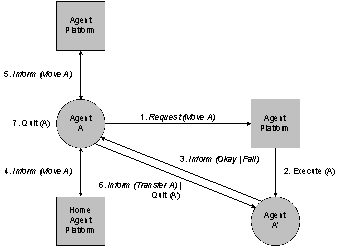
Figure 2: Example Full
Mobility Protocol
It is expected that both of these protocols
(and others) can be appropriate in different application contexts. Therefore,
this specification expects that FIPA AP, that support mobility will implement
either low level or high level mobility protocol, or both.
To initiate agent mobility (such as
migration, cloning or invocation) with the move
operation, the sending agent will identify the mobility protocol to be used for
that mobility operation (see section 2.3, Mobility
Protocols). Using this information, the involved AMS and
agents determine and take subsequent actions to complete the mobility operation
which may involve the use of other operations, such as transfer.
This specification extends the existing
life cycle given in [FIPA00023] by adding a new state (Transit) and two new actions to enter and leave that state (Move and Execute). This allows the current state of the agent to be
represented within the AMS. This new life cycle illustrated in Figure 3.
Only mobile agents can enter the Transit state, or to put it another
way, stationary agents never enter the Transit
state. This ensures that a stationary agent executes all of its instructions on
the node where it was invoked. The actions of agents can be described as:
·
Move
Puts the agent in
a transitory state; this can only be initiated by the agent.
·
Execute
Brings the agent
out of a transitory state; this can only be initiated by the agent system.
The relationship between the life cycle
actions of Move and Execute can be associated with the Agent Management actions
of Move, Transfer and Execute in
the following way. To enter the Transit
state, a mobile agent initiates the execution of a mobility protocol which
involves sending a Move (and
possibly a Transfer in the case of a
full mobility protocol) to an AMS. Correspondingly, a mobile agent is brought
out of the Transit state by an AMS
issuing an execute action upon its code (see section 2.3, Mobility
Protocols).
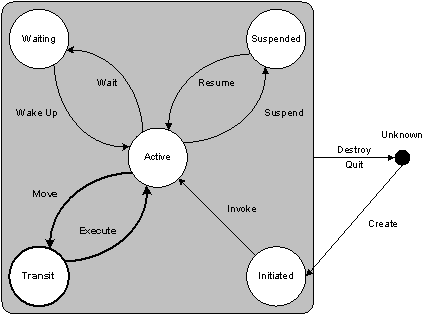
Figure 3: Mobile Agent
Life Cycle
A number of standard protocols have been
defined to cover various forms of agent mobility. Specifically, they address:
·
Agent migration,
·
Agent cloning, and,
·
Agent invocation.
As described in section 2.1, Protocols
as a Metaphor for Expressing Mobility, there are essentially two types of protocols;
simple and full. The simple protocols base most of the functionality of the
mobility operation within the local and remote APs; the full protocols spread
the task across the mobile agent and the APs.
Figures 4 to 9 represent the three mobility
operations for each type of protocol; when an agent wishes to move to another
AP, it can specify one of these as a mobility protocol which describes the
actions and reactions of each involved parties. Other protocols can be
constructed from the actions given in section 3.2, Function
Descriptions to permit flexible and extensible forms of agent
mobility.
The agent migration protocols are invoked
by agents that wish to transport themselves between two APs. The simple migration protocol (see Figure 4) requires that the migrating
agent delegates all responsibility for the migration operation to the APs, who
complete the task on its behalf. By comparison, the full migration protocol (see Figure
5) requires the agent to participate in the migration operation and to
control aspects of its completion; the task is not completed until the transfer
action has been approved.
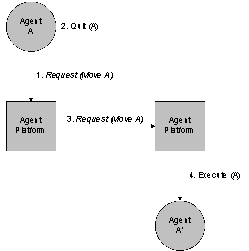
Figure 4: Simple Agent Migration Protocol
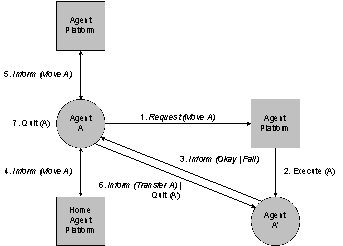
Figure 5: Full Agent
Migration Protocol
The agent cloning protocols are invoked by
agents that wish to create a copy of themselves on an AP. These protocols
follow the same principles and responsibilities as agent migration (see Figure 6 and Figure 7).

Figure 6: Simple Agent
Cloning Protocol
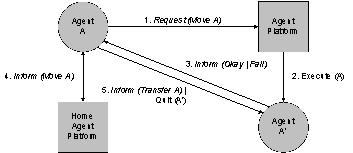
Figure 7: Full Agent
Cloning Protocol
The agent invocation protocols are invoked
by agents that wish to create an agent on an AP. These protocols follow the
same principles and responsibilities as agent migration and agent cloning (see Figure 8 and Figure 9).

Figure 8: Simple Agent
Invocation Protocol

Figure 9: Full Agent
Invocation Protocol
Since a mobile agent can be transported
between APs in a variety of formats it can make a number of demands upon an AP
for a required set of conditions to be met before such an agent can be
executed. Some common examples of the form of a mobile agent might be:
·
Written in Java (version 1.2) using
the Aglets mobile agent toolkit (0.1 beta) represented as serialised byte-code,
·
Written in C represented as native
code compiled for Linux (version 2.2.15) on i386 hardware, or,
·
Written in April (version 4.4)
represented as byte-code.
Each of these dependencies can be expressed
as part of the meta-information of a mobile agent within the :profile
parameter (see section 3.1.2, Mobile Agent Profile). This parameter contains three
description sections which allow various characteristics of the mobile agent to
be specified:
·
:system
Expresses
requirements of the mobile agent system which the mobile agent uses (if any),
such as Aglets, Mole, AgentTcl or Voyager (see section 3.1.3, Mobile
Agent System).
·
:language
Expresses
requirements of the language in which the mobile agent is written, such as Java
source code, i386 native code or April byte-code (see section 3.1.4, Mobile
Agent Language).
·
:os
Expresses
requirements of the operating system for which the mobile agent was intended
(if any), such as a Solaris SPARC box or a Linux i386 box (see section 3.1.5, Mobile
Agent Operating System).
This permits a great deal of flexibility in
stating the execution requirements of a mobile agent and can be used by a
receiving AP to determine whether it can support an agent of that type.
A particular deficiency in any stated profile description section may cause the
agent to be rejected on the grounds of lack of support or for security reasons
(agent-profile-unsupported).
Extra dependency information can be stated
in the :dependencies parameter of each profile description section. This is a free-form
parameter that may or may not be supported by an AP for that particular class
of agent. For example, language dependencies may express additional class
libraries required by the mobile agent and operating system dependencies may
express additional software that should be installed on the OS (such as Perl,
TCL/Tk, etc.).
This ontology represents extensions to the FIPA-Agent-Management ontology defined in [FIPA00023] if mobility is supported.
This
section describes a set of frames, that represent the classes of objects in the
domain of discourse within the framework of the FIPA-Agent-Management ontology.
The
following terms are used to describe the objects of the domain:
·
Frame. This is the mandatory name of
this entity, that must be used to represent each instance of this class.
·
Ontology. This is the name of the
ontology, whose domain of discourse includes the parameters described in the
table.
·
Parameter. This is the mandatory name of
a parameter of this frame.
·
Description. This is a natural language
description of the semantics of each parameter.
·
Presence. This indicates whether each
parameter is mandatory or optional.
·
Type. This is the type of the values of
the parameter: Integer, Word, String, URL, Term, Set or Sequence.
·
Reserved Values. This is a list of
FIPA-defined constants that can assume values for this parameter.
|
Frame
Ontology
|
mobile-agent-description
FIPA-Agent-Management
|
|
|
Parameter
|
Description
|
Presence
|
Type
|
Reserved
Values
|
|
|
The identifier of the agent.
|
|
agent-identifier
|
|
|
profile
|
A list of mobility requirements of the agent.
|
Optional
|
Set of mobile-agent-profile
|
|
|
|
The version of the agent.
|
|
String
|
|
|
|
A list of mobility protocols supported by the
agent.
|
|
Set of String
|
|
|
|
The code-base of the agent
|
|
Byte-Stream
|
|
|
|
The dynamic data (state)
of the agent.
|
|
Byte-Stream
|
|
|
Frame
Ontology
|
mobile-agent-profile
FIPA-Agent-Management
|
|
|
Parameter
|
Description
|
Presence
|
Type
|
Reserved
Values
|
|
|
The mobile agent system environment supported
by the agent.
|
|
mobile-agent-system
|
|
|
language
|
The language environment supported by the
agent.
|
Mandatory
|
mobile-agent-language
|
|
|
|
The operating system environment
supported by the agent.
|
|
mobile-agent-os
|
|
|
Frame
Ontology
|
mobile-agent-system
FIPA-Agent-Management
|
|
|
Parameter
|
Description
|
Presence
|
Type
|
Reserved
Values
|
|
|
The name of the mobile agent system.
|
|
String
|
|
|
major-version
|
The major version of the mobile agent system.
|
Mandatory
|
String
|
|
|
|
The minor version of the
mobile agent system.
|
|
String
|
|
|
|
The dependencies required
by the mobile agent system.
|
|
Set of property
|
|
|
Frame
Ontology
|
mobile-agent-language
FIPA-Agent-Management
|
|
|
Parameter
|
Description
|
Presence
|
Type
|
Reserved
Values
|
|
|
The name of the mobile agent language.
|
|
String
|
|
|
major-version
|
The major version of the mobile agent
language.
|
Mandatory
|
String
|
|
|
|
The minor version of the
mobile agent language.
|
|
String
|
|
|
|
The format of the code
base of the mobile agent.
|
|
String
|
|
|
|
The filter that should be
executed over the code base before execution.
|
|
String
|
|
|
|
The dependencies required
by the mobile agent language.
|
|
Set of property
|
|
|
Frame
Ontology
|
mobile-agent-os
FIPA-Agent-Management
|
|
|
Parameter
|
Description
|
Presence
|
Type
|
Reserved
Values
|
|
|
The name of the operating system.
|
|
String
|
|
|
major-version
|
The major version of the operating system.
|
Mandatory
|
String
|
|
|
|
The minor version of the operating system.
|
|
String
|
|
|
|
The hardware of the
operating system.
|
|
String
|
|
|
|
The dependencies required
by the operating system.
|
|
Set of property
|
|
The
following tables define usage and semantics of the functions that are part of
the FIPA-Agent-Management ontology and that are supported by the agent management services and
agents on the AP.
The following terms are used to describe
the functions of the FIPA-Agent-Management domain:
·
Function. This is the symbol that
identifies the function in the ontology.
·
Ontology. This is the name of the
ontology, whose domain of discourse includes the function described in the
table.
·
Supported by. This is the type of agent
that supports this function.
·
Description. This is a natural language
description of the semantics of the function.
·
Domain. This indicates the domain over
which the function is defined. The arguments passed to the function must belong
to the set identified by the domain.
·
Range. This indicates the range to which
the function maps the symbols of the domain. The result of the function is a
symbol belonging to the set identified by the range.
·
Arity. This indicates the number of
arguments that a function takes. If a function can take an arbitrary number of
arguments, then its arity is undefined.
|
Function
|
move
|
|
|
Ontology
|
FIPA-Mobile-Agent-Management
|
|
|
Supported by
|
AMS
|
|
|
Description
|
An agent issues a move request to transfer itself to a local/remote
AMS. However, the AMS may refuse to accept the move request due to lack of agent profile support or other local
restrictions.
|
|
Domain
|
mobile-agent-description
|
|
Range
|
The
execution of this function results in a change of the state but it has no
explicit result. Therefore there is no range set.
|
|
Arity
|
1
|
|
Function
|
transfer
|
|
|
Ontology
|
FIPA-Mobile-Agent-Management
|
|
|
Supported by
|
AMS
|
|
|
Description
|
An agent issues a transfer request to send its identity and authority to
another agent on a destination AMS. However, the receiving agent may refuse
to accept the transfer request for security reasons.
|
|
Domain
|
mobile-agent-description
|
|
Range
|
The
execution of this function results in a change of the state but it has no
explicit result. Therefore there is no range set.
|
|
Arity
|
1
|
These exceptions extend those defined in
[FIPA00023].
|
Communicative Act
Ontology
|
failure
FIPA-Agent-Management
|
|
|
Predicate symbol
|
Arguments
|
Description
|
|
|
String
|
The
receiving AMS does not support agent mobility.
|
|
|
String
|
The
receiving AMS does not support the specified mobility profile description.
|
|
|
String
|
The
receiving AMS already has an agent registered with the same name as the
migrating agent.
|
The intention of the Mobile Agent Facility
(MAF - see [OMGmaf]) specification is to achieve a certain degree of
interoperability between mobile agent platforms of different manufacturers. A
MAF-compliant agent platform can be accessed via two standardised interfaces that
are specified by means of the OMG's Interface Definition Language (IDL): MAFAgentSystem
and MAFFinder. These interfaces provide fundamental operations for agent
management, agent tracking and agent transport. Note that these interfaces
represent the access point to agent systems and registration components; their
concrete implementation is not specified.
Several similarities between a FIPA AP that
supports agent mobility and a MAF-compliant AP can be drawn regarding their
functionality:
·
The FIPA AMS can be compared to a MAF
agent system, represented by the MAFAgentSystem interface; both are responsible
for the management of agents,
·
The FIPA DF is similar to the MAF
registration component, represented by the MAFFinder interface; the
task of these entities is the maintenance of registration information about
agents in a distributed environment,
·
The equivalent of the Message
Transport System (MTS - see [FIPA00067]) is the Object Request Broker (ORB) in
the context of MAF; these entities care for the transfer of messages in a
distributed agent environment, and,
·
FIPA and MAF provide their
specifications in an implementation-independent way.
Beside these similarities, several
differences have to be mentioned which are mainly associated with the general
design approach of the FIPA specifications and the MAF specification:
·
FIPA standards try to cover the set of
functionality that is required for the execution and support of mobile agents
by means of a high-level speech act language, the ACL, as well as appropriate
content languages. ACL allows for the specification of operations and
high-level communication protocols, and,
·
The MAF specification covers a minimal
set of functionality since it is meant as an add-on to existing agent platforms
rather than as the basis for completely new systems. The functionality of a
MAF-compliant platform is accessible via IDL interfaces. These interfaces
provide, among others, methods for the management (that is, creation,
suspension, resumption and termination), transport and tracking of agents. In
contrast to FIPA, no high-level language is used above the IDL methods.
Instead, each IDL method is directly mapped onto a method of the associated,
implemented object.
Regarding these characteristics of FIPA and
MAF, the two standardisation approaches can be combined to a unified mobile
agent framework. One promising way seems to be the integration of the IDL
operation(s) defined in FIPA for the transfer of ACL messages into the MAF IDL
specifications (see Figure 10). To
realise an agent platform that is FIPA- and MAF-compliant, the following three
possibilities exist:
·
The existing MAF interfaces MAFAgentSystem
and MAFFinder can be enhanced by new operations that enable a FIPA-compliant
platform access,
·
The existing operations of the MAF
interfaces can be modified in order to adapt them to the requirements of the
FIPA specifications, and,
·
Completely new interfaces are
specified additionally to the existing MAF interfaces.
While the first two approaches require
modification of the existing MAF specification, the third approach can be
regarded as a pure extension that does not require any changes.
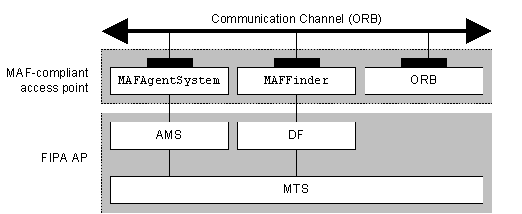
Figure 10: Integration of
FIPA and MAF
However, the FIPA specifications could be
enhanced by some "specialised" methods as defined in the MAF
specification. This could be desirable for methods that have a simple parameter
structure and that can be sufficiently represented without using a high-level
content language.
[FIPA00023] FIPA Agent
Management Specification. Foundation for Intelligent
Physical Agents, 2000. http://www.fipa.org/specs/fipa00023/
[FIPA00067] FIPA Agent Message
Transport Service Specification. Foundation for
Intelligent Physical Agents, 2000. http://www.fipa.org/specs/fipa00067/
[OMGmaf] OMG Mobile
Agent Facility Specification. Object Management Group,
2000. http://www.omg.org/cgi-bin/doc?formal/00-01-02.pdf









